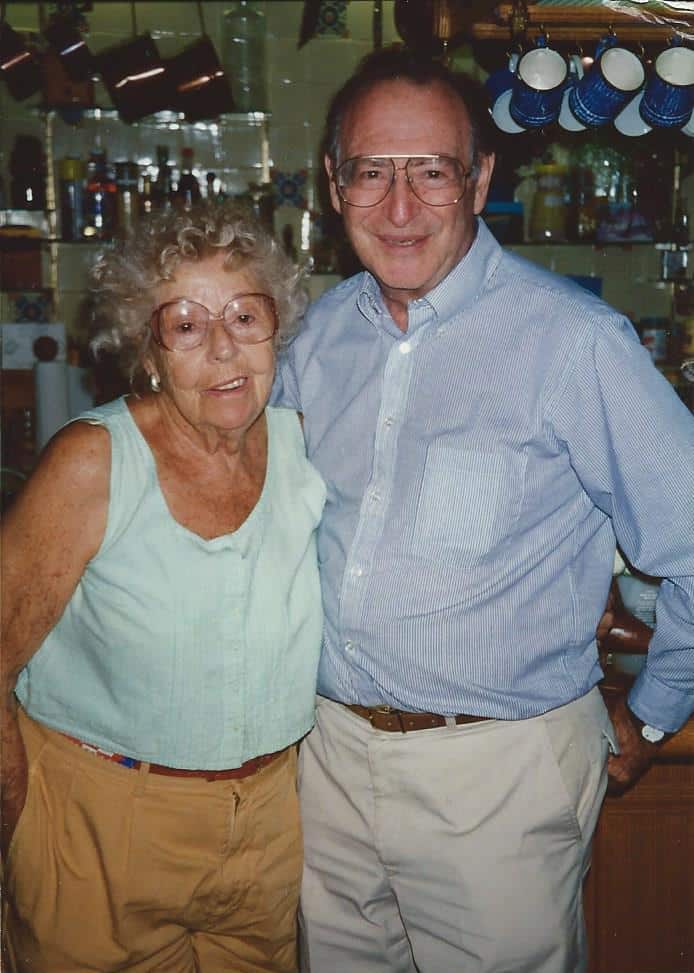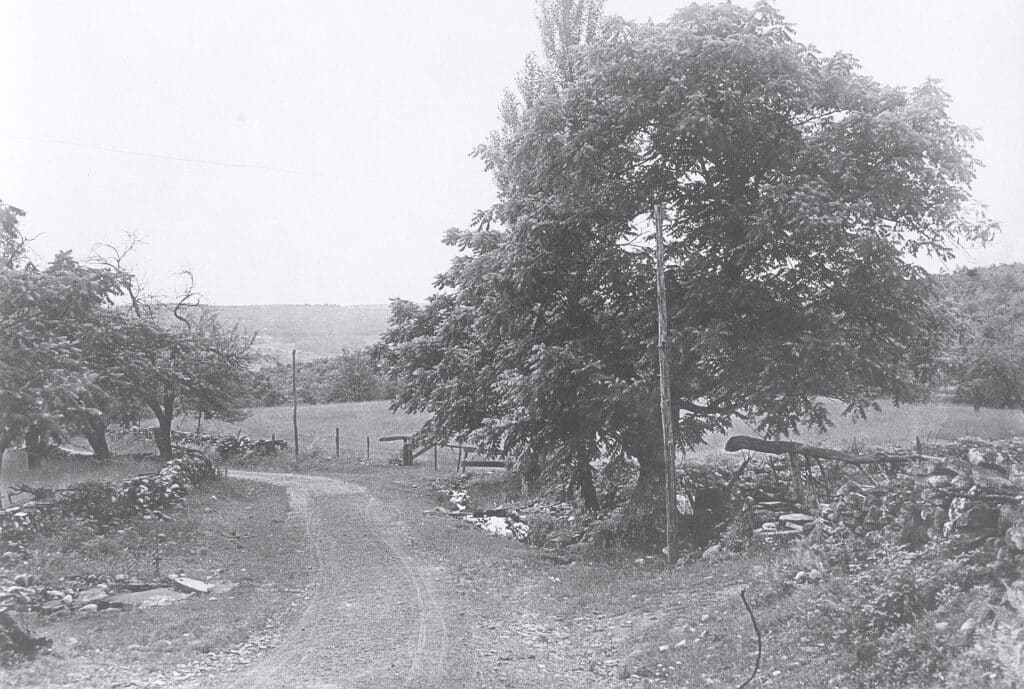Our Close Neighbor
When the owner of a house on Brandt Road discovered his new neighbors were running a summer camp for children from New York City, he put his house on the market. The prospective buyers, Walter and Jacqueline Mehr, drove from New York City to see the property around Labor Day in 1969. They drove past people enjoying their first weekend retreat at the newly purchased Camp Deerpark, to look at a rambling, stone house built in 1810. “As soon as I saw it I fell in love with it,” Walter said. “Before we left after that first visit, I said I’d buy the house. The owner asked me, ‘Don’t you want to negotiate price or something?’ I said no. ”When the Mehrs were in the final stages of the purchase of the house, the owner found out Walter and Jacqueline were Jewish and tried to stop the sale. The Mehrs prevailed and purchased their new house along with 300 acres of surrounding land. They moved from Park Avenue and 66th Street to a road with no stoplights, where they could look out of their window at night and see the eyes of many deer in the field across the road. “I loved the isolation,” Walter said.
“I’ve always been happy with having camp as a neighbor,” he said. “It made me happy to see children from the city spend two weeks in the country.” At 95 years old, Walter said he had many memories of staff he has seen come and go at camp. “I think Dale is the first person I met from camp,” he said. “And I am still in touch with Marian Sauder and Orville. And Arden and Carolyn Landis. We went to see them in Pennsylvania.” Jerry and Leonor Kennel, Jim and Valerie Baer, and Ken and Deborah Bontrager were other names he mentioned. “The people have been very good neighbors,” he said.“They always plow me out when it snows. Jim Baer would plow me out before he plowed at camp.”
In 1985, Dale was driving to camp and was about to turn onto Brandt Road when he saw fire engines. He was stopped and told he could not drive up the road. Dale asked where the fire was. “It’s up at Mr. Mehr’s,” the fireman said.
“I was able to drive to camp and walked up the hill to check on you,” Dale said. “You and Jacqueline weren’t there at the time, but I saw that the fire had destroyed most of your home. That was a very sorry thing to see.”
When Dale saw Walter and Jacqueline later on, he asked if they needed a place to stay. “I remember coming up and offering to let you stay in one of the cabins,” he said.
“Which we did,” said Walter.
“We learned to know each other better at that time and became closer friends,” Dale said. “That was your home for about half a year.”
“Five months. Until I built the apartment behind our garage. Then we moved in there until our house was rebuilt.
”Walter was an architect, an inventor and an art collector. “I lost some paintings,” he said. “And some patents on inventions were destroyed because of the fire.”
“I hired a local man to help rebuild the house,” Walter said. “Some of the structure was still there. I designed the house and paid for him to go to a school in Michigan to learn timber framing. When he returned, and was almost finished framing the house, he made an anti-Semitic remark to me. He wasn’t finished assembling the house, but I was done with him. That was a terrible thing.”
Walter was born in Germany in 1921. He and his father spent four months in a concentration camp in 1938. When they were in the camp, “my mother wrote to relatives in the United States. At that time, if you had a sponsor, you could get out of the camp to leave the country.” Walter’s father had a cousin in the United States who was a barber. “He didn’t have much money,” Walter said. “But he sent an affidavit and sponsored us–my parents, me and my brother. We came here to get away from Hitler. That was in 1939.”
“Jacqueline lived in Switzerland during the war, but her parents died in a concentration camp in Germany,” Walter said.
Jacqueline and Walter met in New York City. Jacqueline was a window designer in the city and on Long Island. Walter sometimes worked for his brother, who was a manufacturer of Christmas ornaments. Jacqueline met Walter when she went to purchase ornaments to decorate a window on Madison Avenue. When she went to pay, Walter said, “No, but if you’re free for dinner we’ll have dinner together.” Walter took Jacqueline to a restaurant about an hour outside of the city.
“Tell me something about yourself,” Jacqueline had said to Walter.
“I have an apartment on 66th and Park Avenue. And I have a poodle,” Walter said with a smile. “I was bragging.”
When Jacqueline found out that Walter had not had a chance to walk or feed his dog before leaving, she made him drive back to his apartment immediately without eating. As Walter walked his dog, Jacqueline made dinner. “When I came back she had dinner on the table,” he said. “I asked about driving her home and she said she wasn’t leaving.”
“After that we were never separated,” Walter said, his eyes tearing. “She was a great girl.”
Jacqueline died in 2012, two months shy of 104.
“I treat my women well,” Walter said.
Walter continued to live alone up on the hill. He has help with cooking and cleaning. “And I can’t put on my socks anymore,” he said. His house is both beautiful and fascinating—meticulously crafted and decorated with unique touches. Many European farm-scene paintings grace the walls. Part of an oak tree rises through two floors, and a 16-foot carved wooden giraffe, purchased from Ten Thousand Villages many years ago, towers over the living room.
Brandt Road
Brandt Road was originally a stage coach road from Port Orange to Monticello. According to Al Mann, a neighbor who lives on Brandt Road, the original house on the Walter Mehr property was a stop on the stage coach route.
We walked through the house with Walter before we left. He walked up a narrow, winding staircase, up three flights—slowly and carefully—in order to proudly show us a very large painting from Brussels he had purchased for his 90th birthday. “It would only fit on this wall,” he said, when we had reached the top floor. “I love art and I like to see my money on the wall, not in the bank.”
At 95, Walter had a sharp memory about many things. Throughout the interview, when asked about camp, Walter repeatedly said: “Camp was always a good neighbor to us. I’ve always been happy with camp. I was happy to see kids from the city coming to the country. It still makes me very happy.”
—Written on October 15, 2016 by Donna Stoltzfus, former camper and staff.
Walter Mehr passed away on January 3, 2018.
Dale Stoltzfus, first director of camp, attended Glad Tidings Mennonite Church in the Bronx.
Related Entries
Share:
“How Do I Donate?”
Recently, a thirteen-year-old guest at Camp asked Operations Director Kevin Smith, “how do I donate?” Kevin was honestly a little surprised, but was happy to see this young member – who was on retreat with one of our owning churches — taking some initiative. Kevin directed him to the website Donate page, and the young…
The Discipleship Down-Low
Defining Discipleship 18 And Jesus came and said to them, “All authority in heaven and on earth has been given to me. 19 Go therefore and make disciples of all nations, baptizing them in the name of the Father and of the Son and of the Holy Spirit, 20 teaching them to observe all that I have commanded…
The Virtuous Wife
This past weekend, Camp hosted three women’s retreats at Camp. Though the retreat groups were very diverse in background – one was from an urban church plant in Philadelphia, one was from a Garifuna Mennonite church in Brooklyn (an Afro-Caribbean Culture), and one was from a multi-ethnic faith community reaching out in North Jersey. Though…
A Life of Service
I believe the most important thing to God is not our personality, knowledge, or talents, but our availability. How willing and ready are we to respond when He calls, and how ready are we to do what He says? What use to the Lord are people who could do what he wants with excellence and…
Building Belonging
At our February NYC LMC District meeting, we’re discussing the Belonging phase of The Journey Map. In this first phase on the map, individuals and groups on a spiritual journey begin the process of connecting to each other and evaluating the place they may have in each other’s lives. Have you ever been an outsider…
What Are You Tapped Into?
Yesterday we began tapping maple trees, officially opening maple syrup making season at Camp Deerpark! Last year, the transition kept us from producing syrup, so it feels great to be back to it. Starting off, however, has been a bit of a challenge since things are pretty arctic around here. The entire ground is covered…
What Does it Mean to be Spirit-Led with Pastor Mark Perri
One small contribution I can make is to share story with you. This could be valuable in several ways: First, I’m coming to the Mennonites from the outside — from non-denominational GenX “simple/ organic/ emergent church“. Sometimes people coming from outside-in have a helpful perspective for those trying to move from inside-out. Second, as an…
2025 NYC LMC District Call Schedule
Mark these dates in your calendar if you’re part of the NYC LMC District and want to attend the English-language fellowship and resourcing calls led by Bishop Hyacinth Stevens: January 27th – 6:30 PM February 24th – 6:30 PM March 31st – 6:30 PM April 28th – 6:30 PM May 19th – 6:30 PM June 30th…
Winter: Life Under the Surface
On the surface, winter with its cracking and cold seems like the enemy of life. Everything sleeps as though dead, and Camp — quiet and empty — sits waiting. But under the surface, winter is revealed to be a friend to life, not an enemy. In the deep frost, God opens the soil for Spring’s…
Peace Making Presents
This is Session 4 of the Prince of Peace: Jesus and Peacebuilding from the Election to the Holidays webinar series. Advent celebrates the central fact that God began building peace with us by giving a Gift. Following this example, gifts are a powerful tool for peacebuilding in our lives, relationships, and organizations. We’ll explore how…





